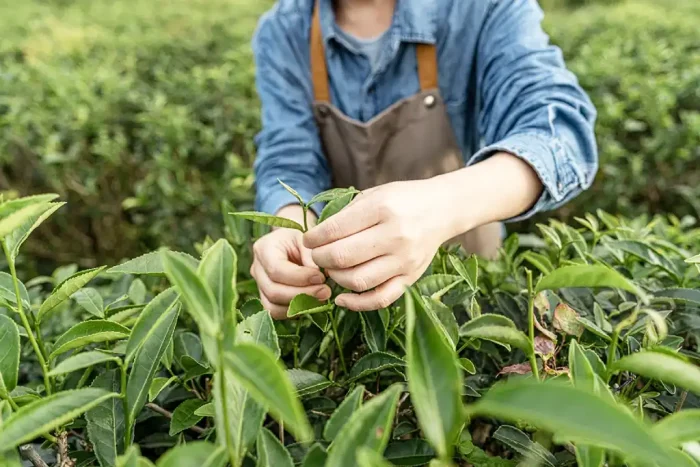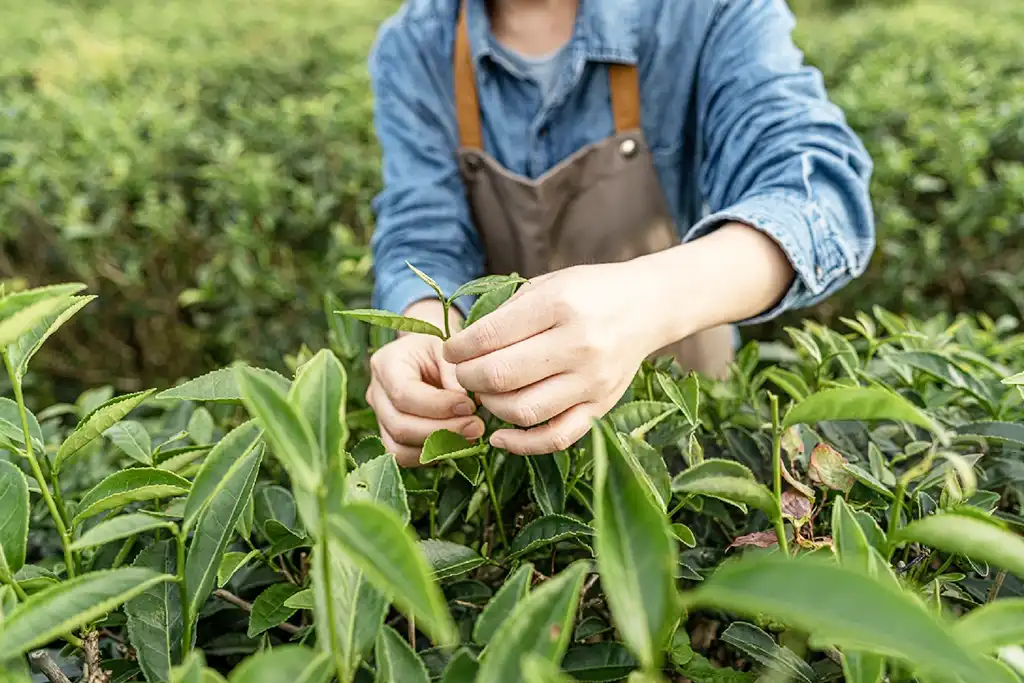Last Updated on March 28, 2025

For those new to the world of tea, the myriad types and varieties can appear bewildering and daunting. What distinguishes black tea from green tea? How does herbal tea differ from rooibos? Can you discern whites from oolongs or purples from pu-erhs?
At ArtfulTea, we stock nearly a hundred different tea types, giving us expertise in simplifying the tea landscape for you. We take pleasure in guiding both newcomers and seasoned tea enthusiasts through their tea journey. Our informative tea guide is designed to help individuals, whether beginners or experts, delve deeper into the realm of tea.
Tea Derived from the Camellia Sinensis Plant
All authentic teas originate from the same source: the Camellia sinensis plant. This plant, rooted in southern China for millennia, has been cultivated and enjoyed for hundreds of years. Camellia sinensis boasts two primary varietals: Camellia sinensis var. sinensis, predominantly found in China and other East Asian regions, featuring a milder character; and Camellia sinensis var. assamica, mainly grown in India, known for its heartier and more robust nature.
Black tea, green tea, white tea, oolong tea, pu-erh tea, and purple tea all share the Camellia sinensis origin. Each of these teas acquires its distinct traits through diverse harvesting and processing techniques. Some are steamed, while others are pan-fired; some undergo oxidation, while others do not. Tea leaves may be hand-formed into tight rolls, roughly chopped, or left to air-dry in their natural form. Harvesting can occur in the early weeks of spring, summer, or fall, contributing to a range of flavors and appearances. The tea processing methods developed over centuries have given rise to six primary tea categories, each with its unique characteristics and processing methods.
Black Tea
Black tea is widely recognized, with brands like Lipton and Tetley offering it in mainstream teabags. Morning favorites such as English Breakfast and Irish Breakfast are typical examples of black tea. Black teas generally contain relatively high caffeine levels, about half that of coffee, resulting in a rich, robust flavor and a dark, coppery brew.
Black tea is produced by harvesting, wilting, and lightly crushing the tea leaves. Some black teas, such as Irish Breakfast, undergo further fragmentation through a process known as crush-tear-curl (CTC). The tea leaves then fully oxidize, transforming into a brownish-black hue.
Black tea is primarily cultivated in China and India, with countries like Sri Lanka, Nepal, Vietnam, and Kenya emerging as significant exporters of black tea. Indian black teas are often stronger and more robust, well-suited for hearty breakfast blends with milk and sweetener. Meanwhile, Chinese black teas tend to be lighter and milder, generally enjoyed without any additives. Notable Chinese black teas include China Keemun and Golden Yunnan.
Green Tea
Green tea, another product of the Camellia sinensis plant, yields a light green or yellow brew with a delicate body and mild flavor. It contains about half the caffeine of black tea, making it a healthier alternative to coffee. Popular green teas encompass Gunpowder, Jasmine Yin Cloud, and Moroccan Mint.
The production of green tea involves harvesting, immediately steaming, or pan-frying to arrest oxidation. This preservation process results in the tea’s bright green color and its light, vegetal taste. Afterward, the tea leaves are rolled or pressed into their final shape and dried.
Green tea primarily hails from China and Japan. Japanese green teas are characterized by their steaming process, rendering a slightly savory, oceanic quality and an emerald green hue. Some Japanese teas are also shaded for several weeks before harvesting to intensify their chlorophyll, caffeine, and l-theanine content. Notable Japanese green teas include Sencha, Kukicha, and Gyokuro.
Chinese green teas, on the other hand, are pan-fired post-harvest to halt oxidation, resulting in milder teas with a golden hue, light body, and a mellow flavor. Popular Chinese green teas include Dragon Well, Gunpowder, and Chun Mee.
White Tea
White tea, a minimally processed delicacy, is highly sought after by connoisseurs and enjoyed by both novices and experts. With its light body and mild flavor culminating in a crisp, clean finish, white tea is relatively low in caffeine, making it an excellent choice for those sensitive to caffeine.
The production of white tea involves minimal processing, with certain varieties, such as silver tip and silver needle teas, being harvested from the first tips and buds of the tea plant before they unfurl into full leaves. Other white teas, like White Peony, are harvested once the leaves fully unfurl, receiving minimal oxidation.
White tea is predominantly produced in China, particularly in the Fujian province, renowned for its rich white tea history. Some specialty white teas also originate from regions like Nepal, Taiwan, and Sri Lanka.
Oolong Tea
Oolong tea falls between black and green teas in terms of oxidation, with a range of 10-80%. This results in a brew that varies from pale yellow to rich amber, offering multiple infusions with nuanced flavor changes.
Oolong teas like Milk Oolong are typically cultivated from unique tea plant varietals developed over the years to impart distinctive flavors. After harvesting, the leaves are withered and undergo partial oxidation, with the extent of oxidation varying by oolong type. Some oolong teas are meticulously hand-rolled into small, tightly rolled balls before drying.
The primary producers of oolong teas are China and Taiwan. In China, notable oolong-producing regions include the Wuyi Mountains and Anxi in Fujian province, as well as Guangdong province. Taiwan, an island near mainland China, is renowned for its specialty oolongs, including the highly sought-after Milk Oolong.
Pu-erh Tea
Pu-erh tea, an aged, partially fermented variety, shares similarities with black tea in character. It brews into an inky brown-black infusion with a full-bodied, earthy, and deeply satisfying taste. Pu-erh tea contains a substantial caffeine content, equivalent to black tea, making it an ideal choice for those seeking a stimulating experience.
To produce pu-erh tea, leaves are initially processed similarly to green tea: harvested, steamed or pan-fried, and shaped before drying. However, the leaves then undergo a fermentation process, leading to two primary types of pu-erh: sheng and shou. Sheng pu-erh follows a traditional, gradual aging process, while shou pu-erh adopts a modern, accelerated fermentation method. Both types are typically aged for several years, enhancing their rich, earthy flavors.
Pu-erh tea originated in Pu-erh, a city in the Yunnan province of China, where it remains the primary production region. Although other provinces, such as Hunan and Guangdong, produce similar aged teas, only teas from Yunnan can be officially labeled as pu-erh.
Purple Tea
Purple tea is a relatively recent addition to the tea landscape, commercially available for only a few years. It is crafted from a rare purple-leaved tea plant initially discovered growing wild in the Assam region of India. Today, Kenya, Africa is the primary producer of purple teas, which offer a light body, mild
flavor, extremely low caffeine, and high levels of antioxidants and anthocyanins.
The production of purple tea typically follows processes similar to oolong teas. Leaves are harvested, withered, and partially oxidized, imparting the tea’s unique reddish-purple hue.
Purple tea’s origins can be traced back to the Assam region of India, where the unique tea plants were initially found. Later, they were transplanted to Kenya, where the Tea Research Foundation of Kenya worked on cultivating a cultivar suitable for commercial tea production. Kenya now stands as the largest producer of purple tea, with the Tumoi Tea Garden in the Nandi Hills providing some of our sourced purple teas.
Matcha
Matcha is a finely powdered green tea popular in Japan, renowned for its versatility. It can be whisked with water for a pure tea or incorporated into lattes, smoothies, and baked goods. Matcha boasts a smooth, rich flavor with hints of umami and a subtle touch of bitterness.
Matcha production begins with tea plants shaded for at least three weeks before harvest, increasing their chlorophyll content and contributing to the tea’s unique emerald green color. The leaves are steamed immediately after harvesting, halting oxidation. To make matcha, these leaves are stone-ground into a fine powder.
Matcha has its origins in China during the Tang Dynasty, with Chinese monks introducing both Buddhism and matcha to Japan in the 12th century. The ceremonial use of matcha among Japanese monks gained rapid popularity, eventually spreading to Japan’s upper classes by the 15th century. Over time, an elaborate tea ceremony surrounding matcha was developed, leading to its association with Japan today.
Mate Tea
Mate tea, derived from a plant native to South America, closely resembles tea but is not related to the Camellia sinensis tea plant. Mate contains caffeine and is traditionally prepared in a hollow gourd by steeping leaves and hot water. The tea is consumed through a filtered straw known as a bombilla. In various South American countries, mate is a communal experience, with friends sharing a gourd and passing it among themselves. Mate can also be prepared like other teas and tisanes, using infusers or filters in a mug or pot.
Herbal Tea
Despite colloquially referring to them as “tea,” herbal teas are not related to true teas produced from the Camellia sinensis plant. Herbal teas are blends of different herbs and spices, generally devoid of caffeine. A wide array of herbal teas exists, encompassing single-ingredient teas like Peppermint and Chamomile, as well as imaginative blends such as Lavender Lullaby and Atomic Gold. Herbal blends often possess medicinal properties, making them suitable for various ailments, from soothing sore throats to calming upset stomachs.
Rooibos Teas
Rooibos tea, also known as red tea or red bush tea, is a specific type of herbal tea originating from a plant native to South Africa. These teas are caffeine-free and offer a full-bodied character akin to black tea. Rooibos boasts a natural sweetness and can be enjoyed on its own or with a touch of milk. It can also be combined with other ingredients to create flavored blends such as Earl Grey Rooibos and Rooibos Chai.
Understanding Tea Categories
In the world of tea, fundamental categories simplify the understanding of processing and the expected flavor profile. Beyond these categories, numerous tea varietals, growing conditions, and processing methods result in a wide range of flavors and characteristics, influenced by the unique terroir of each environment.
Ultimately, the world of tea is as diverse as the tea producers themselves. Whether you’re an aspiring tea enthusiast or a devoted tea connoisseur, the journey through the ever-evolving world of tea promises endless exploration and appreciation!
- 20 Affordable Meal Prep Companies and Food Subscriptions Boxes for Busy Families
- 3 Amazing Low-Calorie Meal Preparation Ideas For Busy Moms
- 4 Absolute Mouthwatering Fruit Charcuterie Board Ideas
- 4 Dinner Party Games For Adults For Your NYE Party (Plus Dinner Ideas!)
- 5 Amazing Holiday Cocktail Menu for Cozy Nights With Close Friends
- 5 Delicious, Guilt-Free Super Bowl Desserts You Can Easily Make
- 5 Effective Ways To Get The Most Out Of Your Protein Shakes
- 5 Practical Ways to Stop Sugar Cravings
- 6 High Protein Vegetable Smoothie Recipes Your Taste Buds Will Love
- 6 Mouth-Watering Superfood Recipes That Are Easy to Make
- 6 Restaurants With Great Cocktails in Orlando
- 7 New Years Eve Drinks and Cocktails Menu to Cheer The Year
- 8 Tips to Get Great Intermittent Fasting Results
- Christmas Dinner For Two: The Perfect Food For a Cozy Night
- Christmas Dinner Ideas: Elevate Your 2024 Holiday Feast with Delicious Inspiration
- Clean Eating Breakfast Ideas to Help Start Your Day
- Creating the Ultimate Cinco de Mayo Menu in 7 dishes
- Do Artificial Sweeteners Break A Fast?
- Favorite Comfort Foods: Indulge in Timeless Classics
- Food Garden: 5 Ways You Can Start Your Own At Home
- How to Build the Perfect Spooky Graveyard Terrarium [DIY Tutorial]
- How to Cook Asparagus in 5 Simple and Tasty Ways
- How to Stop Eating When Bored: Tips, Snack Ideas, and More
- Ideal Coffee Shop with Outdoor Seating: Discover 12 Unmissable Listings
- Most popular and delicious Mexican dishes
- Review: Crumbl Cookies in Winter Park + Our 3 Favorite Irresistible Flavors!
- StoneFruit Coffee Co. is a Coffee Lovers Dream 2021
- Thanksgiving Party Guide: 5 Steps For an Awesome Friendsgiving Dinner
- The Benefits of Organic Turmeric and Turmeric Supplements
- The Ultimate Girls Night in Checklist: 6 Games, Playlists, and Drinks
- Unraveling the Delightful Mystery: What is Bubble Tea?
- Upscale Drinks: 7 Amazing Cocktails You Can Make at Home
- What Should I Eat for Dinner and When? A Dietitian’s Opinion 2024
- Which Green Juice Powder Is Better? Organifi vs Amazing Grass 2024 [REVIEW]
- The Tamarind Benefits: Exploring its Rich History, Flavor, and Health Advantages
- What are the all types of drinks?
Meet Kourtney, a writer specializing in sex and relationships. Known for her honest and insightful approach, she explores themes of intimacy and personal growth. Her work combines personal anecdotes, expert opinions, and practical advice, helping readers navigate the complexities of modern relationships and embrace their desires. Kourtney's writing serves as a guide for those seeking authentic and fulfilling connections.
- This author does not have any more posts.


